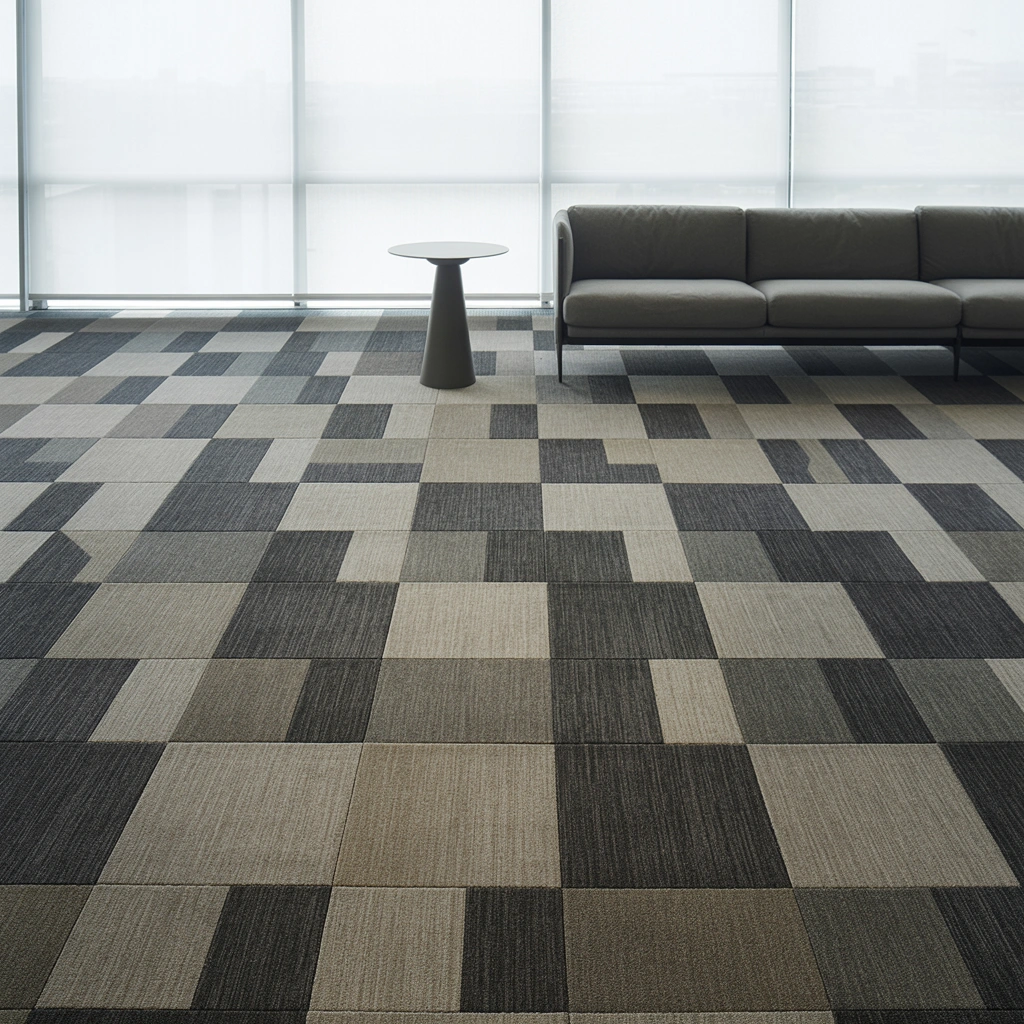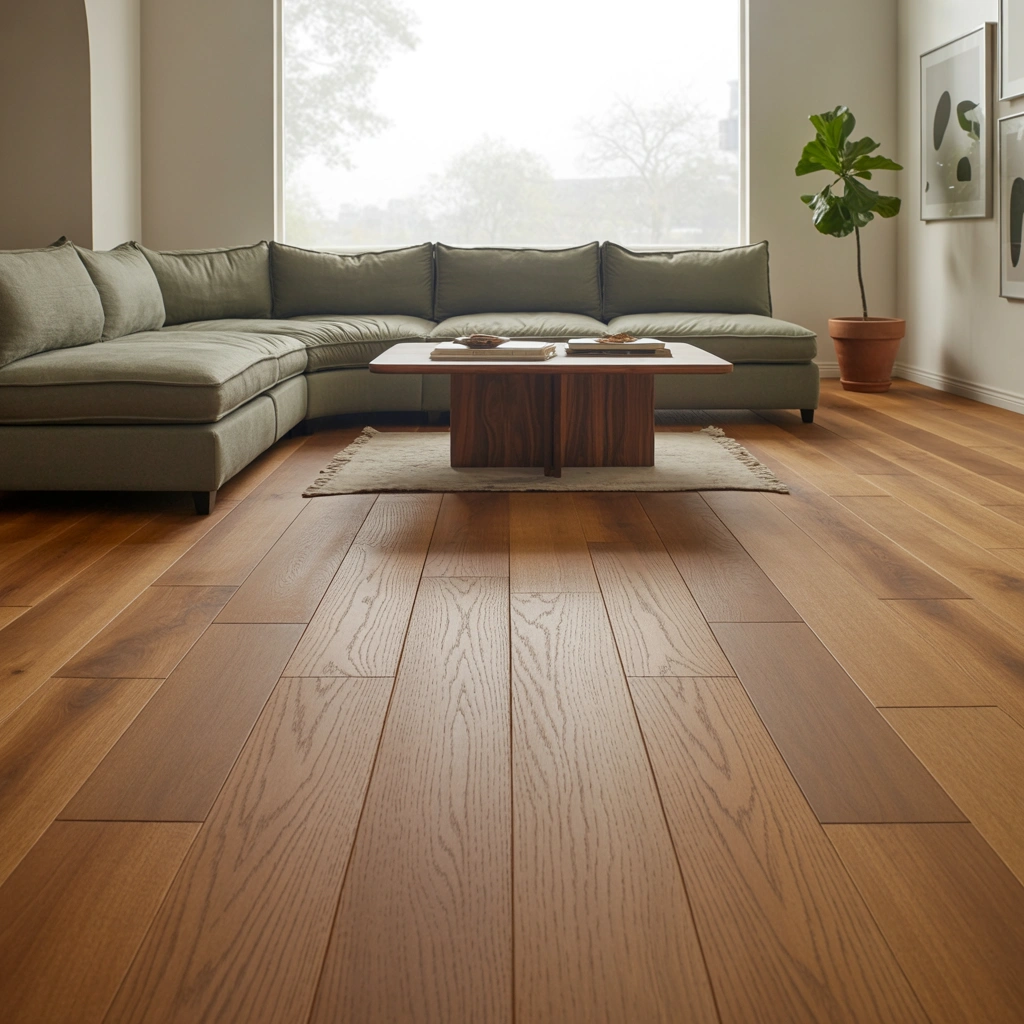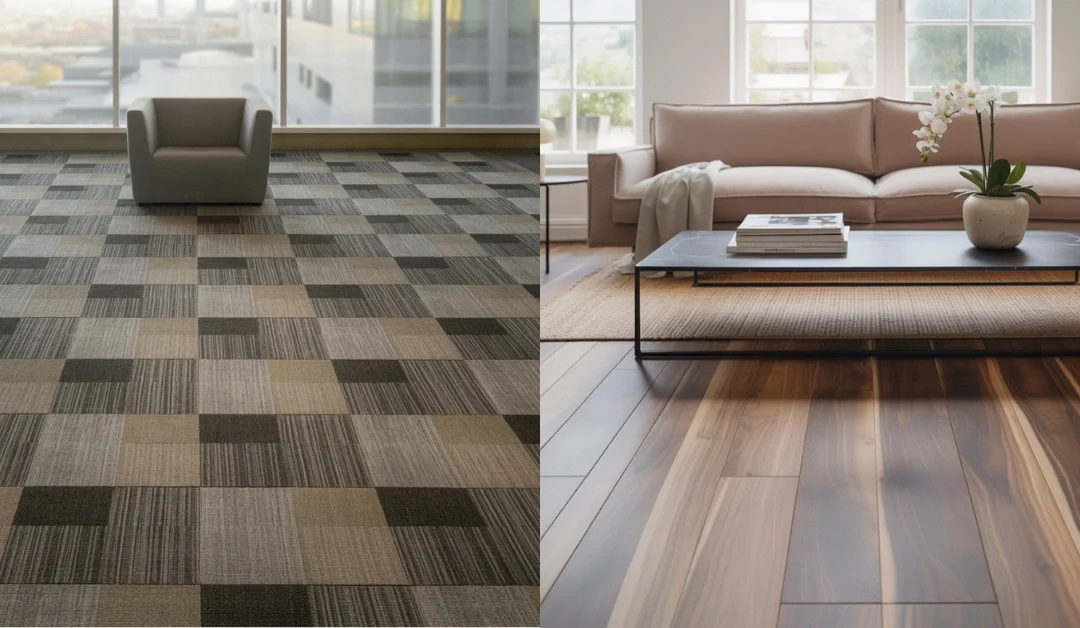Flooring is more than just a surface to walk on. It affects comfort, safety, and even the value of your home. For example, homes in Dubai or Abu Dhabi with high-quality flooring often sell faster.
At Jenah Interiors, many customers ask: “Should I choose carpet tiles or wood flooring?” Both options have pros and cons, but the choice depends on your lifestyle, budget, and style. Let’s dive in!
1. What Are Carpet Tiles and How Do They Work?

Carpet tiles are small squares of carpet, usually 50cm x 50cm or 1m x 1m in size. They are glued to the floor or clicked together like puzzle pieces. These tiles are popular in offices, schools, and even homes because:
- They’re easy to replace. If one tile gets stained or damaged, it can be swapped without redoing the whole floor.
- They’re affordable. Compared to wood flooring, carpet tiles are cheaper upfront.
- They’re soundproof. The soft material absorbs noise, making it ideal for busy spaces.
However, carpet tiles can trap dust, dirt, and pet hair. Regular vacuuming is needed to keep them clean.
2. What Exactly Is Wood Flooring and What Are Its Types?
Wood flooring is made from natural timber and comes in two main types:
- Solid Wood: Cut from a single piece of timber. It can be sanded and refinished multiple times, lasting over 100 years!
- Engineered Wood: Made of layers, with a thin top layer of real wood. It’s more stable in humid climates like Dubai.
Wood floors are known for their timeless beauty and warmth. They’re often chosen for living rooms, bedrooms, and dining areas.
3. Which Is Better: Carpet Tiles or Wood Flooring — A Detailed Comparison
Are Carpet Tiles Cheaper Than Wood Flooring?
Yes! On average, carpet tiles cost AED 50–150 per square meter, while wood flooring starts at AED 200 per square meter. At Jenah Interiors, prices for luxury flooring options like Arabic Down Majlis start at AED 850 per m², but basic wood floors are more affordable.
Why carpet tiles are cheaper:
- Made from synthetic materials (nylon, polyester).
- Easier to install.
- No need for special underlayment.
Why is wood flooring more expensive?
- Uses natural timber.
- Requires professional installation.
- Needs regular maintenance (polishing, refinishing).
Is Wood Flooring Easier to Install Than Carpet Tiles?
No. Carpet tiles are designed for DIY installation. They can be laid directly over a clean, flat surface. Wood flooring, especially solid wood, needs:
- Acclimatization: The wood must adjust to the room’s humidity for 72 hours before installation.
- Special tools: A nail gun or adhesive is required.
- Expertise: Uneven subfloors can ruin the finish.
Engineered wood is easier to install than solid wood, but still harder than carpet tiles.
Which Lasts Longer: Carpet Tiles or Wood Flooring?
Wood flooring wins here. With proper care, it can last 25–100 years. Carpet tiles typically last 10–15 years, depending on foot traffic.
Factors affecting lifespan:
- Carpet tiles: Wear from shoes, pets, or heavy furniture can flatten fibers.
- Wood flooring: Scratches, water damage, or poor maintenance can shorten its life.
How Much Maintenance Do Carpet Tiles and Wood Floors Require?
- Carpet tiles: Need vacuuming twice a week and steam cleaning every 6 months. Spills should be wiped immediately to avoid stains.
- Wood flooring: Sweep daily and mop weekly with a damp cloth. Avoid excessive water, which can warp the wood.
Pro Tip: Use doormats to reduce dirt and protect both flooring types.
Which Is More Comfortable Underfoot: Carpet Tiles or Wood Flooring?
Carpet tiles are softer and warmer, making them great for kids’ rooms or play areas. Wood floors are harder but can be paired with rugs for comfort.
Which Looks Better: Carpet Tiles or Wood Flooring?
This depends on your style!
- Carpet tiles come in bold colors and patterns, perfect for modern or playful spaces.
- Wood flooring adds elegance and suits traditional or minimalist designs.
Which Flooring Option Is Better for People With Allergies?
Wood flooring is better for allergy sufferers. Carpets trap dust mites, pollen, and pet dander, which can worsen symptoms.
4. What Are the Pros and Cons of Using Carpet Tiles in Your Space?
Pros:
- Affordable: Lower upfront cost.
- Soundproof: Reduces noise in multi-story buildings.
- Cozy: Soft texture feels warm underfoot.
- DIY-friendly: Easy to install and replace.
Cons:
- High maintenance: Needs frequent cleaning.
- Short lifespan: Wears out faster in high-traffic areas.
- Not waterproof: Spills can cause mold if not cleaned quickly.
5. What Are the Pros and Cons of Installing Wood Flooring?

Pros:
- Durable: Lasts decades with proper care.
- Adds value: Increases home resale price.
- Elegant look: Timeless appeal that never goes out of style.
- Hypoallergenic: Doesn’t trap allergens like carpets.
Cons:
- Expensive: High initial cost.
- Sensitive to moisture: Can warp in humid climates.
- Requires maintenance: Needs polishing and refinishing every few years.
6. Which Flooring Works Best for Different Rooms in the House?
Is Wood Flooring or Carpet Tiles Better for Living Rooms?
Wood flooring is ideal for living rooms. It’s easy to clean and gives a luxurious feel. Pair it with a rug for added comfort.
Should I Use Carpet Tiles or Wood Flooring in the Bedroom?
Carpet tiles are cozier for bedrooms, especially in winter. Their softness makes them perfect for bare feet.
Can I Install Wood Flooring or Carpet Tiles in the Kitchen?
No! Neither is suitable for kitchens. Water spills can ruin both. Choose ceramic tiles or vinyl flooring instead.
Which Is Ideal for Commercial Spaces: Carpet Tiles or Wood Flooring?
Carpet tiles are the top choice for offices. They’re quiet, durable, and easy to fix if damaged.
Which Flooring Is Suitable for Basements: Carpet Tiles or Wood?
Avoid wood in basements due to moisture risks. Carpet tiles are okay if the basement is dry and climate-controlled.
7. How Eco-Friendly Are Carpet Tiles Compared to Wood Flooring?
Wood flooring is more eco-friendly if sourced sustainably. Look for FSC-certified wood (Forest Stewardship Council). Carpet tiles use synthetic materials that take centuries to decompose.
At Jenah Interiors, many eco-conscious customers choose reclaimed wood flooring. It’s durable and reduces deforestation.
8. How Much Do Carpet Tiles and Wood Flooring Cost to Install?
| Flooring Type | Cost per m² | Installation Cost |
|---|---|---|
| Carpet Tiles | AED 50–150 | AED 20–50 |
| Wood Flooring | AED 200–800 | AED 100–200 |
Cost-Saving Tips:
- Buy leftover carpet tiles for small rooms.
- Choose engineered wood instead of solid wood.
9. Can You Install Carpet Tiles or Wood Flooring Yourself?
Yes! Carpet tiles are perfect for DIY projects. Wood flooring, however, is best left to professionals unless you have experience.
DIY Steps for Carpet Tiles:
- Measure the room.
- Clean the floor thoroughly.
- Lay tiles in a staggered pattern for a neat look.
10. How Do You Maintain Carpet Tiles vs Wood Flooring Over Time?
Carpet Tiles Maintenance:
- Vacuum twice a week.
- Spot-clean spills with a mild detergent.
- Replace damaged tiles promptly.
Wood Flooring Maintenance:
- Sweep daily with a soft broom.
- Mop weekly with a damp cloth.
- Refinish every 5–10 years.
11. Conclusion: Which Flooring Option Should You Ultimately Choose?
Think about your budget, lifestyle, and style. For luxury and resale value, pick wood flooring. For comfort and low cost, choose carpet tiles. Visit Jenah Interiors to see samples and get expert advice!
12. Frequently Asked Questions About Carpet Tiles vs Wood Flooring
Carpet tiles are cheaper upfront.
Yes! They’re a top-selling point for buyers.
Yes, because they’re easy to replace.
Solid wood can be sanded and polished many times.
Not really. They’re made from plastic.

